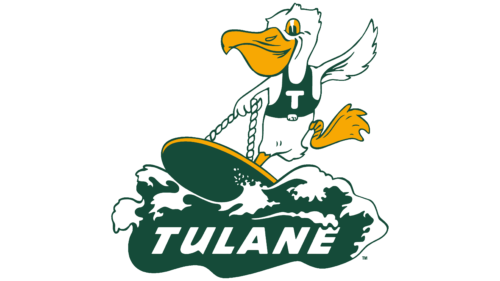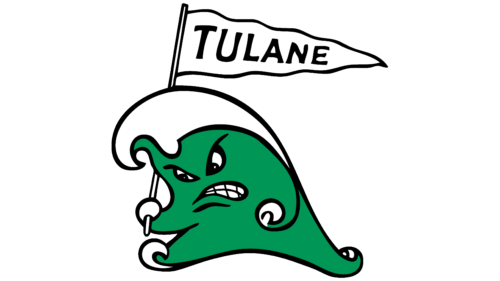The designers created the Tulane Green Wave logo with the image of their mascot – Angry Wave- for the university players. Until recently, it was used as a secondary sign, but in 2017, athletes again made it their main symbol. And before that, the teams were represented by the so-called T-Wave: the letter “T” that fell into the tsunami.
Tulane Green Wave: Brand overview
| Founded: | 1893 |
| Headquarters: | New Orleans, Louisiana, U.S. |
| Website: | tulanegreenwave.com |
The Tulane University of Louisiana is actively involved in intercollegiate sports competitions. He was a founding member of the Southeastern Conference in 1932 and has been a member of the American Athletic Conference since 2014. The school owns the Tulane Green Wave teams, which received this nickname after the publication of the song “The Rolling Green Wave.” They currently play in NCAA Division I.
The earliest Tulane University teams were formed in 1893 (football, baseball) and 1905 (men’s basketball). At first, they were officially called The Olive and Blue, while the fans gave them the nickname Greenbacks or Greenies. Football players showed themselves well in competitions in 1900 and 1912, setting several records.
Meaning and History
Perhaps Tulane Green Wave received its current name because of the numerous victories. It is taken from the song “The Rolling Green Wave,” which was published in 1920 in the school newspaper Tulane Hullaballo. The author of the text was the then editor of the publication – Earl Sparling. The rest of the press picked up the new nickname a month later.
The original name was reflected in the logo, created in 1964. After that, he disappeared for almost 20 years, but in 2017 he returned to replace the already rather boring T-Wave icon and restore the former glory of the mascot named Gumby.
What is Tulane Green Wave?
Tulane Green Wave is an intercollegiate athletics competitor representing the Tulane University of Louisiana. All teams play at the NCAA Division I level, and almost all are members of the American Athletic Conference, except two that are members of the Coastal Collegiate Sports Association and the Southland Bowling League. The New Orleans-based institution sponsors 14 sports, including volleyball, tennis, football, basketball, and baseball.
1920 – 1924
When the Tulane University sports teams took their current name instead of the old The Olive and Blue, they began using the green wave emblem. She was “caught” by a pelican standing on a surfboard and wearing a T-shirt with a white “T.” The bird has raised one paw and flaps its wing to keep its balance. This shows her drive and high skill – the qualities of athletes that the artists tried to convey through the image of an anthropomorphic pelican. Below, the word “TULANE” is written in bold and cursive on the water. This logo is known to have been used in the 1920s over an indefinite period.
1964 – 1986
In 1945, teams got the Greenie mascot, which looked like a little boy wearing a football helmet. But he was only relevant until 1964 because the new athletic director of Rix Yard, who took over in 1963, felt the mischievous character was not masculine enough. Thus began the first attempts to visualize the green wave, which at the same time was supposed to be aggressive. Rix Yard teamed up with bookstore manager Eldon Endacott to create a new mascot. A couple of ideas came from Art Evans of Angelus-Pacific. As a result, the Angry Wave character and the logo with his image appeared. In this version, he looks like an angry green hat with scowling eyes and a vicious grin. The wave has improvised arms and legs while holding a white pennant with “TULANE” written in black.
1986 – 1998
In 1986, the first emblem from the T-Wave series was adopted. Its main element is a large block “T” in turquoise. It seems massive because of the rectangular serifs. Two wavy stripes are crossed diagonally in the middle: white and blue.
1998 – 2005
On August 19, 1998, sports teams got a new logo – this time with the image of a gray pelican, which tilted its head down and spread its wings. Its orange beak strikes the blue water, spraying dark turquoise droplets to the right and left. The lower half of the logo is occupied by the large word “TULANE” and the reduced phrase “GREEN WAVE.” The dark green capital letters are in bold italics, with some of them having original serifs.
2005 – 2014
In 2005, the old Tulane Green Wave logo created back in 1986, returned. The designers modernized it by changing the shape of the letter “T,” which is now tilted to the right and outlined in a double gray-blue outline. From the left, a turquoise wave sweeps over it, but not completely – the emblem captures a freeze frame when the water reaches the top of the “T.”
2014 – 2017
After a little refinement, the wave became a rich green and acquired a shade of Kelly Green. The rest of the colors didn’t change. The shape of the elements also remained the same.
2017 – today
The Angry Wave has once again become the official symbol of the Tulane University sports teams. The designers modernized it by turning it to the right side and making the character’s facial expressions more expressive. Unlike the old version from 1964, the current logo uses a darker shade of green, with the top painted bright blue. Remarkably, now in the hands of an anthropomorphic wave is not a triangular pennant but a large white mouthpiece with a black inscription “TULANE.”
Font and Colors
Despite the long pause in using the Angry Wave as the main logo, its popularity has not waned over the years. This character, which appeared more than half a century ago, has become one of the most famous symbols of Tulane Green Wave along with T-Wave.
The name of the university is in bold sans-serif type. The letters get progressively smaller towards the end of the word because they match the width of the mouthpiece. The inscription and all outlines are black; some elements are white. But for the main part of the drawing, the official colors of the sports teams are used: olive and blue, which were chosen back in 1893. They are #006747 (olive green) and #418FDE (sky blue).
Tulane Green Wave color codes
| Bottle Green | Hex color: | #006747 |
|---|---|---|
| RGB: | 0 103 71 | |
| CMYK: | 100 0 31 60 | |
| Pantone: | PMS 3415 C |
| Bleu de France | Hex color: | #418fde |
|---|---|---|
| RGB: | 65 148 222 | |
| CMYK: | 71 36 0 13 | |
| Pantone: | PMS 2925 C |












